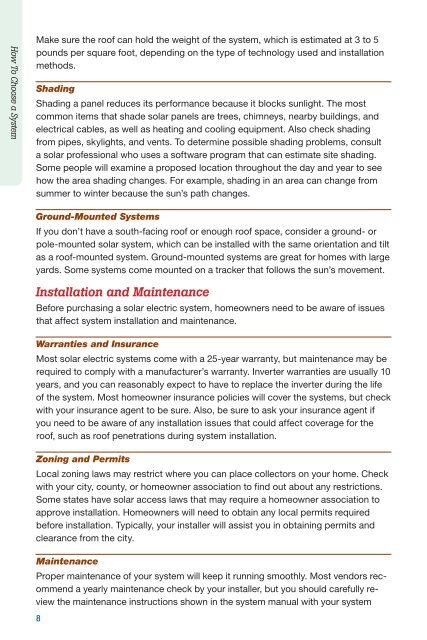Own Your Power! A Consumer Guide to Solar Electricity for the - NREL
Own Your Power! A Consumer Guide to Solar Electricity for the - NREL
Own Your Power! A Consumer Guide to Solar Electricity for the - NREL
You also want an ePaper? Increase the reach of your titles
YUMPU automatically turns print PDFs into web optimized ePapers that Google loves.
How To Choose a System<br />
Make sure <strong>the</strong> roof can hold <strong>the</strong> weight of <strong>the</strong> system, which is estimated at 3 <strong>to</strong> 5<br />
pounds per square foot, depending on <strong>the</strong> type of technology used and installation<br />
methods.<br />
Shading<br />
Shading a panel reduces its per<strong>for</strong>mance because it blocks sunlight. The most<br />
common items that shade solar panels are trees, chimneys, nearby buildings, and<br />
electrical cables, as well as heating and cooling equipment. Also check shading<br />
from pipes, skylights, and vents. To determine possible shading problems, consult<br />
a solar professional who uses a software program that can estimate site shading.<br />
Some people will examine a proposed location throughout <strong>the</strong> day and year <strong>to</strong> see<br />
how <strong>the</strong> area shading changes. For example, shading in an area can change from<br />
summer <strong>to</strong> winter because <strong>the</strong> sun’s path changes.<br />
Ground-Mounted Systems<br />
If you don’t have a south-facing roof or enough roof space, consider a ground- or<br />
pole-mounted solar system, which can be installed with <strong>the</strong> same orientation and tilt<br />
as a roof-mounted system. Ground-mounted systems are great <strong>for</strong> homes with large<br />
yards. Some systems come mounted on a tracker that follows <strong>the</strong> sun’s movement.<br />
Installation and Maintenance<br />
Be<strong>for</strong>e purchasing a solar electric system, homeowners need <strong>to</strong> be aware of issues<br />
that affect system installation and maintenance.<br />
Warranties and Insurance<br />
Most solar electric systems come with a 25-year warranty, but maintenance may be<br />
required <strong>to</strong> comply with a manufacturer’s warranty. Inverter warranties are usually 10<br />
years, and you can reasonably expect <strong>to</strong> have <strong>to</strong> replace <strong>the</strong> inverter during <strong>the</strong> life<br />
of <strong>the</strong> system. Most homeowner insurance policies will cover <strong>the</strong> systems, but check<br />
with your insurance agent <strong>to</strong> be sure. Also, be sure <strong>to</strong> ask your insurance agent if<br />
you need <strong>to</strong> be aware of any installation issues that could affect coverage <strong>for</strong> <strong>the</strong><br />
roof, such as roof penetrations during system installation.<br />
Zoning and Permits<br />
Local zoning laws may restrict where you can place collec<strong>to</strong>rs on your home. Check<br />
with your city, county, or homeowner association <strong>to</strong> find out about any restrictions.<br />
Some states have solar access laws that may require a homeowner association <strong>to</strong><br />
approve installation. Homeowners will need <strong>to</strong> obtain any local permits required<br />
be<strong>for</strong>e installation. Typically, your installer will assist you in obtaining permits and<br />
clearance from <strong>the</strong> city.<br />
Maintenance<br />
Proper maintenance of your system will keep it running smoothly. Most vendors recommend<br />
a yearly maintenance check by your installer, but you should carefully review<br />
<strong>the</strong> maintenance instructions shown in <strong>the</strong> system manual with your system<br />
8

















